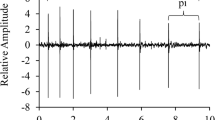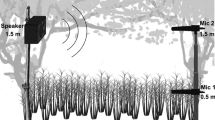Abstract
We examined the sounds made by displaying male capercaillies on a lek in the Black Forest for infrasonic components. Vocalizations did not contain infrasound, whereas flutter jumps produced substantial low-frequency sound energy, with regularly spaced frequency peaks and maximum energy below 20 Hz. This pattern was found in recordings from different distances and for all tested individuals. Nonvocal infrasound may be significant in territorial behavior or orientation of capercaillie.

Similar content being viewed by others
References
Moss R, Lockie I (1979) Infrasonic components in the song of the capercaillie Tetrao urogallus. Ibis 121:95–97
Schust M (1997) Biologische Wirkung von vorwiegend luftgeleitetem Infraschall. Schriftenr. d. Bundesanstalt f. Arbeitsschutz u. Arbeitsmedizin, Ld 7, Bremerhaven
Kreithen ML, Quine DB (1979) Infrasound detection by the homing pigeon: a behavioural audiogram. J Comp Physiol 129:1–4
Hagstrum JT (2001) Infrasound and the avian navigational map. J Navig 54(3):377–391
Klinke R, Schermuly L (1986) Inner ear mechanics of the crocodilian and avian basilar papillae in comparison to neuronal data. Hear Res 22:183–184
Gleich O, Manley GA (1988) Quantitative morphological analysis of the sensory epithelium of the starling and pigeon basilar papilla. Hear Res 34:69–85
Sand O, Enger PS, Karlsen HE, Knudsen F, Kvernstuen T (2000) Avoidance responses to infrasound in downstream migrating European silver eels Anguilla anguilla. Environ Biol Fishes 57(3):327–336
Marti C (1995) Das schweizerische Auerhuhn-Schutzprojekt. Naturschutzreport 10:47–56
Tschirch W (2001) Infraschall-Kommunikation bei Vögeln. Ornithol Mitt 53:166–171
Berglund B, Hassmen P, Job SRF (1996) Sources and effects of low frequency noise. J Acoust Soc Amer 99(5):2985–3002
Lieser M, Roth K (2001) Tetrao urogallus L. 1758 – Auerhuhn In: Hölzinger J, Boschert M (eds) Die Vögel Baden-Württembergs 2.2. Ulmer, Stuttgart, pp 54–77
Mack AL, Jones J (2003) Low-frequency vocalizations by cassowaries (Casuarius spp.). The Auk 120(4):1062–1068
Acknowledgements
We thank the Otto Wolff-Foundation for substantial financial support. The Forest Administration of Baden-Württemberg (FVA, R. Suchant) helped to arrange fieldwork in cooperation with local forest owners and hunters. U. Querner, A. Schmidt and T. Feyen assisted in technical preparations. We are especially grateful to W. Ebser who provided access to the lek and valuable help in the field.
Author information
Authors and Affiliations
Corresponding author
Additional information
Communicated by F. Bairlein
Rights and permissions
About this article
Cite this article
Lieser, M., Berthold, P. & Manley, G.A. Infrasound in the capercaillie (Tetrao urogallus). J Ornithol 146, 395–398 (2005). https://doi.org/10.1007/s10336-005-0003-y
Received:
Revised:
Accepted:
Published:
Issue Date:
DOI: https://doi.org/10.1007/s10336-005-0003-y




